Medical Ethics and Legal Implications: A Nursing Case Study Analysis
VerifiedAdded on 2020/02/24
|9
|2102
|31
Report
AI Summary
This report presents a comprehensive analysis of a nursing ethics case study involving potential medical malpractice. The case examines the ethical and legal responsibilities of healthcare professionals, particularly concerning informed consent and patient autonomy. It delves into the elements of offense in medical malpractice, the grounds for defense, and potential outcomes of legal proceedings. The report applies principles of bioethics, including beneficence and autonomy, to the case, highlighting conflicts between these principles. It also utilizes the Kerridge model of problem-solving to address ethical dilemmas. The analysis explores the legal and ethical considerations, providing insights into the complexities of medical decision-making and the importance of ethical conduct in the healthcare sector. The report concludes by emphasizing the impact of ethical dilemmas on both patients and professionals and the role of legal frameworks and ethical models in resolving such issues. The references used provide a strong foundation for the analysis.
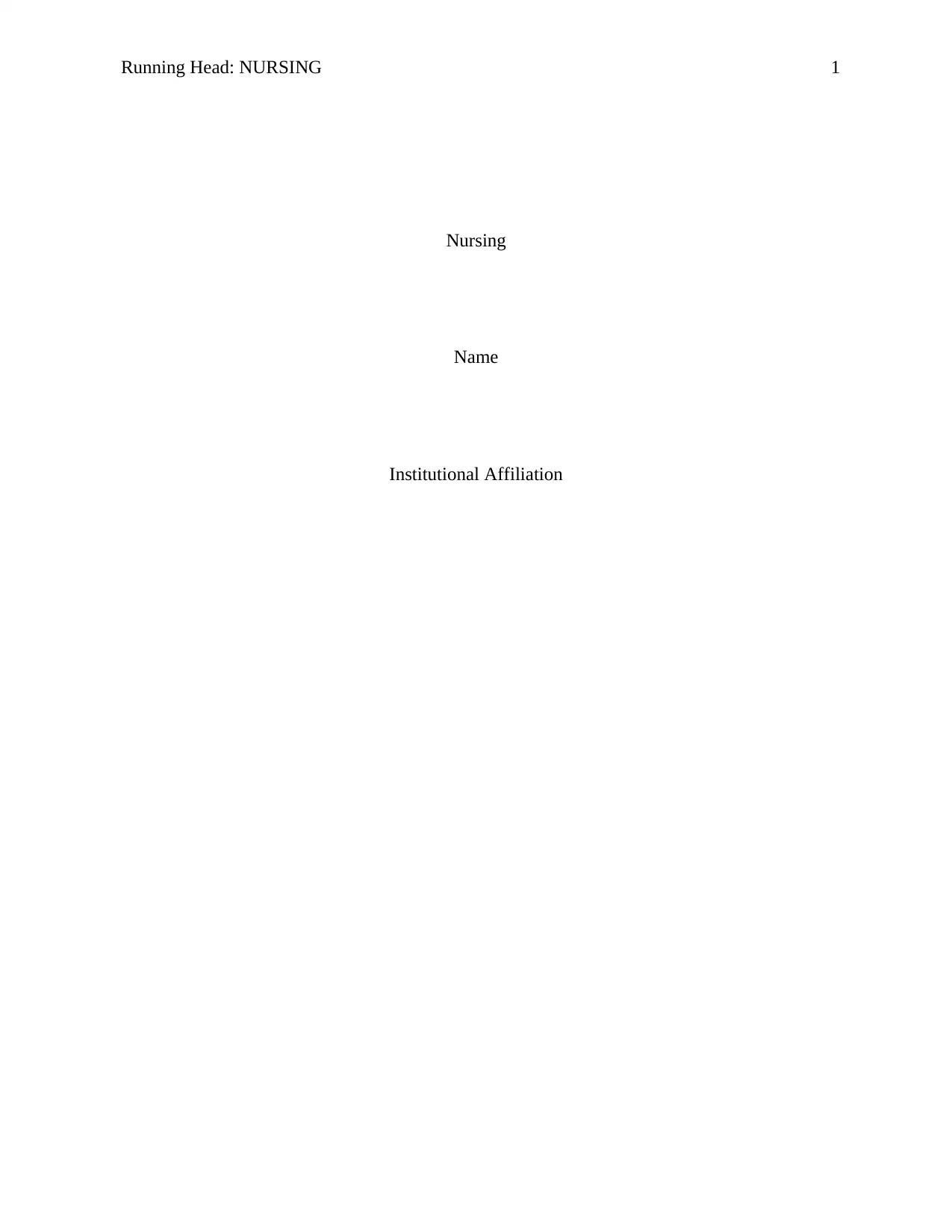
Running Head: NURSING 1
Nursing
Name
Institutional Affiliation
Nursing
Name
Institutional Affiliation
Paraphrase This Document
Need a fresh take? Get an instant paraphrase of this document with our AI Paraphraser
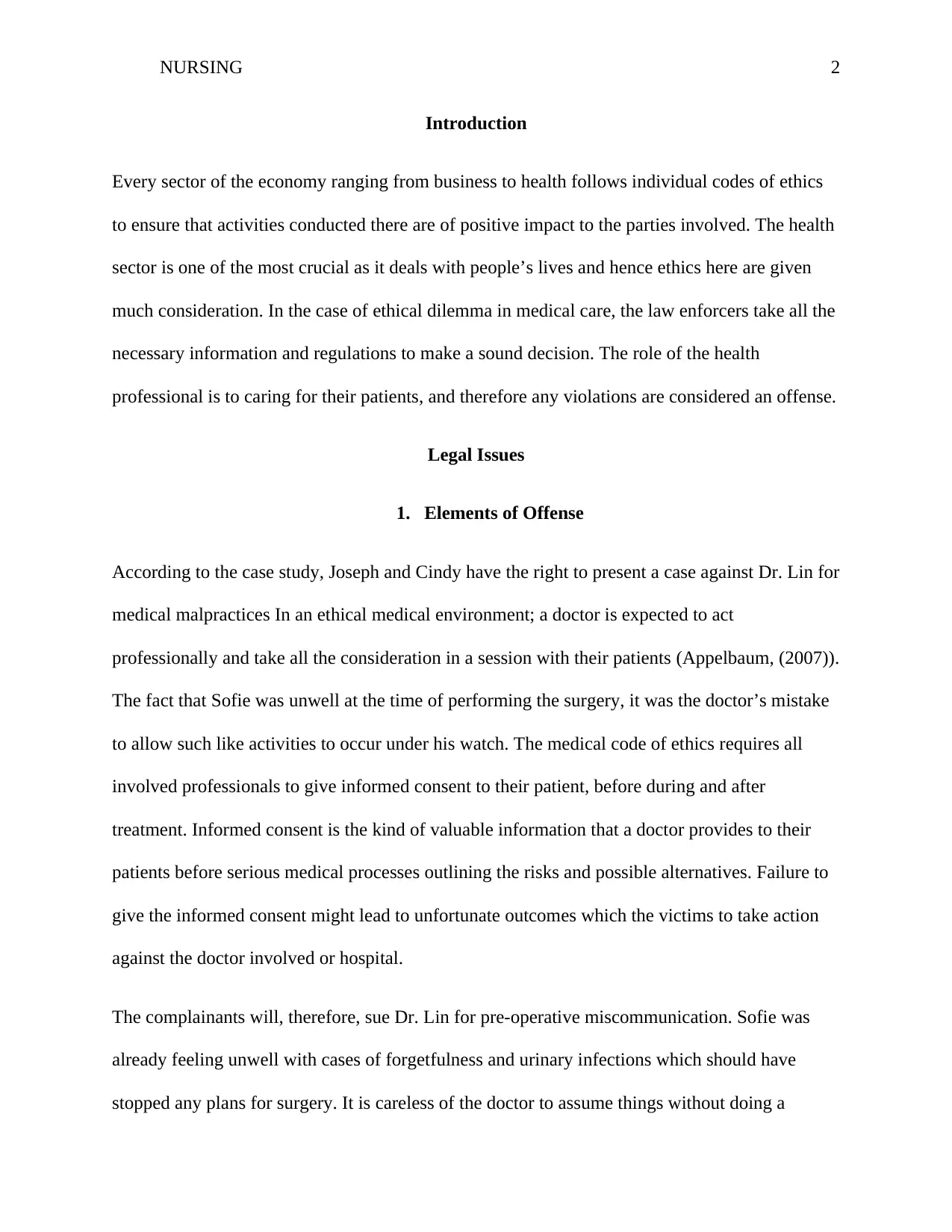
NURSING 2
Introduction
Every sector of the economy ranging from business to health follows individual codes of ethics
to ensure that activities conducted there are of positive impact to the parties involved. The health
sector is one of the most crucial as it deals with people’s lives and hence ethics here are given
much consideration. In the case of ethical dilemma in medical care, the law enforcers take all the
necessary information and regulations to make a sound decision. The role of the health
professional is to caring for their patients, and therefore any violations are considered an offense.
Legal Issues
1. Elements of Offense
According to the case study, Joseph and Cindy have the right to present a case against Dr. Lin for
medical malpractices In an ethical medical environment; a doctor is expected to act
professionally and take all the consideration in a session with their patients (Appelbaum, (2007)).
The fact that Sofie was unwell at the time of performing the surgery, it was the doctor’s mistake
to allow such like activities to occur under his watch. The medical code of ethics requires all
involved professionals to give informed consent to their patient, before during and after
treatment. Informed consent is the kind of valuable information that a doctor provides to their
patients before serious medical processes outlining the risks and possible alternatives. Failure to
give the informed consent might lead to unfortunate outcomes which the victims to take action
against the doctor involved or hospital.
The complainants will, therefore, sue Dr. Lin for pre-operative miscommunication. Sofie was
already feeling unwell with cases of forgetfulness and urinary infections which should have
stopped any plans for surgery. It is careless of the doctor to assume things without doing a
Introduction
Every sector of the economy ranging from business to health follows individual codes of ethics
to ensure that activities conducted there are of positive impact to the parties involved. The health
sector is one of the most crucial as it deals with people’s lives and hence ethics here are given
much consideration. In the case of ethical dilemma in medical care, the law enforcers take all the
necessary information and regulations to make a sound decision. The role of the health
professional is to caring for their patients, and therefore any violations are considered an offense.
Legal Issues
1. Elements of Offense
According to the case study, Joseph and Cindy have the right to present a case against Dr. Lin for
medical malpractices In an ethical medical environment; a doctor is expected to act
professionally and take all the consideration in a session with their patients (Appelbaum, (2007)).
The fact that Sofie was unwell at the time of performing the surgery, it was the doctor’s mistake
to allow such like activities to occur under his watch. The medical code of ethics requires all
involved professionals to give informed consent to their patient, before during and after
treatment. Informed consent is the kind of valuable information that a doctor provides to their
patients before serious medical processes outlining the risks and possible alternatives. Failure to
give the informed consent might lead to unfortunate outcomes which the victims to take action
against the doctor involved or hospital.
The complainants will, therefore, sue Dr. Lin for pre-operative miscommunication. Sofie was
already feeling unwell with cases of forgetfulness and urinary infections which should have
stopped any plans for surgery. It is careless of the doctor to assume things without doing a
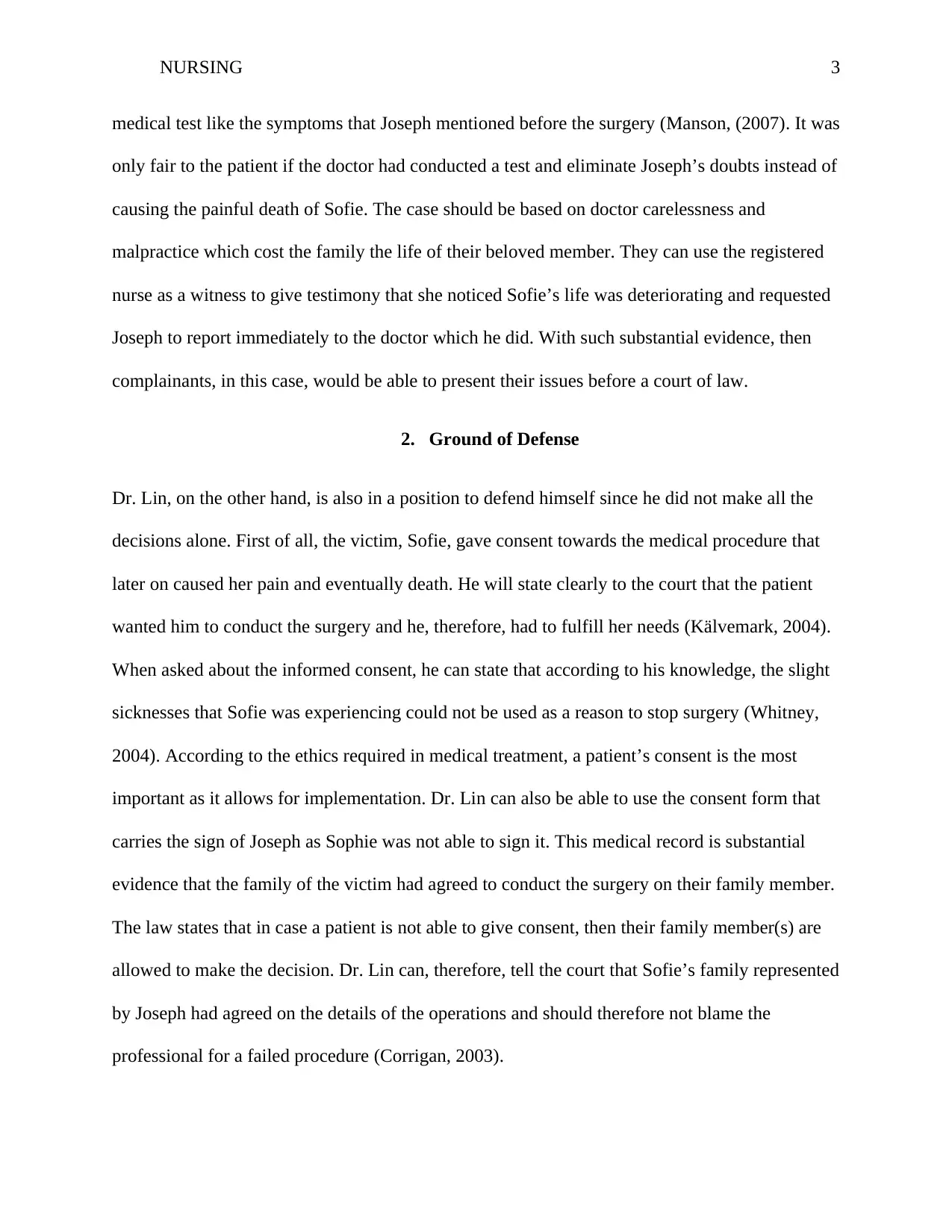
NURSING 3
medical test like the symptoms that Joseph mentioned before the surgery (Manson, (2007). It was
only fair to the patient if the doctor had conducted a test and eliminate Joseph’s doubts instead of
causing the painful death of Sofie. The case should be based on doctor carelessness and
malpractice which cost the family the life of their beloved member. They can use the registered
nurse as a witness to give testimony that she noticed Sofie’s life was deteriorating and requested
Joseph to report immediately to the doctor which he did. With such substantial evidence, then
complainants, in this case, would be able to present their issues before a court of law.
2. Ground of Defense
Dr. Lin, on the other hand, is also in a position to defend himself since he did not make all the
decisions alone. First of all, the victim, Sofie, gave consent towards the medical procedure that
later on caused her pain and eventually death. He will state clearly to the court that the patient
wanted him to conduct the surgery and he, therefore, had to fulfill her needs (Kälvemark, 2004).
When asked about the informed consent, he can state that according to his knowledge, the slight
sicknesses that Sofie was experiencing could not be used as a reason to stop surgery (Whitney,
2004). According to the ethics required in medical treatment, a patient’s consent is the most
important as it allows for implementation. Dr. Lin can also be able to use the consent form that
carries the sign of Joseph as Sophie was not able to sign it. This medical record is substantial
evidence that the family of the victim had agreed to conduct the surgery on their family member.
The law states that in case a patient is not able to give consent, then their family member(s) are
allowed to make the decision. Dr. Lin can, therefore, tell the court that Sofie’s family represented
by Joseph had agreed on the details of the operations and should therefore not blame the
professional for a failed procedure (Corrigan, 2003).
medical test like the symptoms that Joseph mentioned before the surgery (Manson, (2007). It was
only fair to the patient if the doctor had conducted a test and eliminate Joseph’s doubts instead of
causing the painful death of Sofie. The case should be based on doctor carelessness and
malpractice which cost the family the life of their beloved member. They can use the registered
nurse as a witness to give testimony that she noticed Sofie’s life was deteriorating and requested
Joseph to report immediately to the doctor which he did. With such substantial evidence, then
complainants, in this case, would be able to present their issues before a court of law.
2. Ground of Defense
Dr. Lin, on the other hand, is also in a position to defend himself since he did not make all the
decisions alone. First of all, the victim, Sofie, gave consent towards the medical procedure that
later on caused her pain and eventually death. He will state clearly to the court that the patient
wanted him to conduct the surgery and he, therefore, had to fulfill her needs (Kälvemark, 2004).
When asked about the informed consent, he can state that according to his knowledge, the slight
sicknesses that Sofie was experiencing could not be used as a reason to stop surgery (Whitney,
2004). According to the ethics required in medical treatment, a patient’s consent is the most
important as it allows for implementation. Dr. Lin can also be able to use the consent form that
carries the sign of Joseph as Sophie was not able to sign it. This medical record is substantial
evidence that the family of the victim had agreed to conduct the surgery on their family member.
The law states that in case a patient is not able to give consent, then their family member(s) are
allowed to make the decision. Dr. Lin can, therefore, tell the court that Sofie’s family represented
by Joseph had agreed on the details of the operations and should therefore not blame the
professional for a failed procedure (Corrigan, 2003).
⊘ This is a preview!⊘
Do you want full access?
Subscribe today to unlock all pages.

Trusted by 1+ million students worldwide
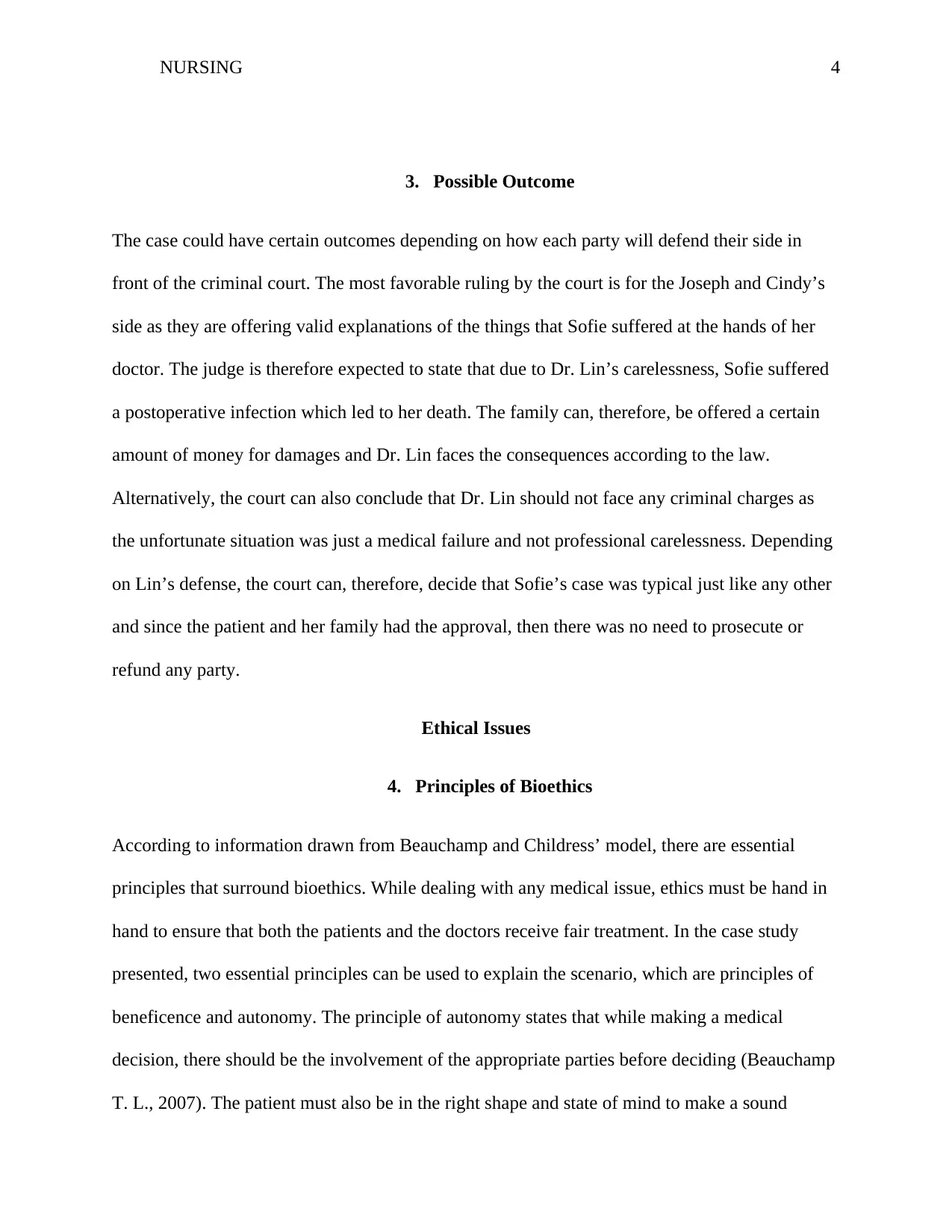
NURSING 4
3. Possible Outcome
The case could have certain outcomes depending on how each party will defend their side in
front of the criminal court. The most favorable ruling by the court is for the Joseph and Cindy’s
side as they are offering valid explanations of the things that Sofie suffered at the hands of her
doctor. The judge is therefore expected to state that due to Dr. Lin’s carelessness, Sofie suffered
a postoperative infection which led to her death. The family can, therefore, be offered a certain
amount of money for damages and Dr. Lin faces the consequences according to the law.
Alternatively, the court can also conclude that Dr. Lin should not face any criminal charges as
the unfortunate situation was just a medical failure and not professional carelessness. Depending
on Lin’s defense, the court can, therefore, decide that Sofie’s case was typical just like any other
and since the patient and her family had the approval, then there was no need to prosecute or
refund any party.
Ethical Issues
4. Principles of Bioethics
According to information drawn from Beauchamp and Childress’ model, there are essential
principles that surround bioethics. While dealing with any medical issue, ethics must be hand in
hand to ensure that both the patients and the doctors receive fair treatment. In the case study
presented, two essential principles can be used to explain the scenario, which are principles of
beneficence and autonomy. The principle of autonomy states that while making a medical
decision, there should be the involvement of the appropriate parties before deciding (Beauchamp
T. L., 2007). The patient must also be in the right shape and state of mind to make a sound
3. Possible Outcome
The case could have certain outcomes depending on how each party will defend their side in
front of the criminal court. The most favorable ruling by the court is for the Joseph and Cindy’s
side as they are offering valid explanations of the things that Sofie suffered at the hands of her
doctor. The judge is therefore expected to state that due to Dr. Lin’s carelessness, Sofie suffered
a postoperative infection which led to her death. The family can, therefore, be offered a certain
amount of money for damages and Dr. Lin faces the consequences according to the law.
Alternatively, the court can also conclude that Dr. Lin should not face any criminal charges as
the unfortunate situation was just a medical failure and not professional carelessness. Depending
on Lin’s defense, the court can, therefore, decide that Sofie’s case was typical just like any other
and since the patient and her family had the approval, then there was no need to prosecute or
refund any party.
Ethical Issues
4. Principles of Bioethics
According to information drawn from Beauchamp and Childress’ model, there are essential
principles that surround bioethics. While dealing with any medical issue, ethics must be hand in
hand to ensure that both the patients and the doctors receive fair treatment. In the case study
presented, two essential principles can be used to explain the scenario, which are principles of
beneficence and autonomy. The principle of autonomy states that while making a medical
decision, there should be the involvement of the appropriate parties before deciding (Beauchamp
T. L., 2007). The patient must also be in the right shape and state of mind to make a sound
Paraphrase This Document
Need a fresh take? Get an instant paraphrase of this document with our AI Paraphraser

NURSING 5
decision. That is where the informed consent comes in as the medical professional should, by all
means, advice their patients on any decision that concern their health (Lo, 2012). The principle is
a way of encouraging the medical professionals to take their jobs seriously and make a positive
impact on the lives of their patients. It was, therefore, Dr. Lin to give professional advice on the
surgery he conducted which could have given a different output.
The other principle is of beneficence requires all the activities performed to be directed towards
the benefit of the patient in any way possible. The medical professionals should, therefore, look
into the health lives of their clients and see if the activities to be conducted will benefit them
(Beauchamp, 2001). Joseph was expecting that his wife’s doctor was making a decision based on
the interest of the patient. The decision to perform surgery should not have gone past the
consideration of how the victim can suffer or benefit. Any operation that knowingly or carelessly
hurts the patient is therefore not following the principle (Goldie, 2000).
5. Conflict between the principles
The principles are however conflicting in the cases where the positive approach of one of the
results to the negativity of the other. In the case, a noble decision made by the doctor might end
up giving negative results that the victims find offensive. The principle of autonomy was
conducted well because all parties involved gave their consent and according to the law, a
medical procedure can now be conducted (Jordens, 2005). The patient was not forced, neither
was her family nor the doctor and were all in good terms. However, after the negative outcome,
it is now clear that the principle of beneficence was not fully implemented. The surgery was not
urgent and could wait until Sofie’s health was better. The doctor decided that even Joseph had
decision. That is where the informed consent comes in as the medical professional should, by all
means, advice their patients on any decision that concern their health (Lo, 2012). The principle is
a way of encouraging the medical professionals to take their jobs seriously and make a positive
impact on the lives of their patients. It was, therefore, Dr. Lin to give professional advice on the
surgery he conducted which could have given a different output.
The other principle is of beneficence requires all the activities performed to be directed towards
the benefit of the patient in any way possible. The medical professionals should, therefore, look
into the health lives of their clients and see if the activities to be conducted will benefit them
(Beauchamp, 2001). Joseph was expecting that his wife’s doctor was making a decision based on
the interest of the patient. The decision to perform surgery should not have gone past the
consideration of how the victim can suffer or benefit. Any operation that knowingly or carelessly
hurts the patient is therefore not following the principle (Goldie, 2000).
5. Conflict between the principles
The principles are however conflicting in the cases where the positive approach of one of the
results to the negativity of the other. In the case, a noble decision made by the doctor might end
up giving negative results that the victims find offensive. The principle of autonomy was
conducted well because all parties involved gave their consent and according to the law, a
medical procedure can now be conducted (Jordens, 2005). The patient was not forced, neither
was her family nor the doctor and were all in good terms. However, after the negative outcome,
it is now clear that the principle of beneficence was not fully implemented. The surgery was not
urgent and could wait until Sofie’s health was better. The doctor decided that even Joseph had
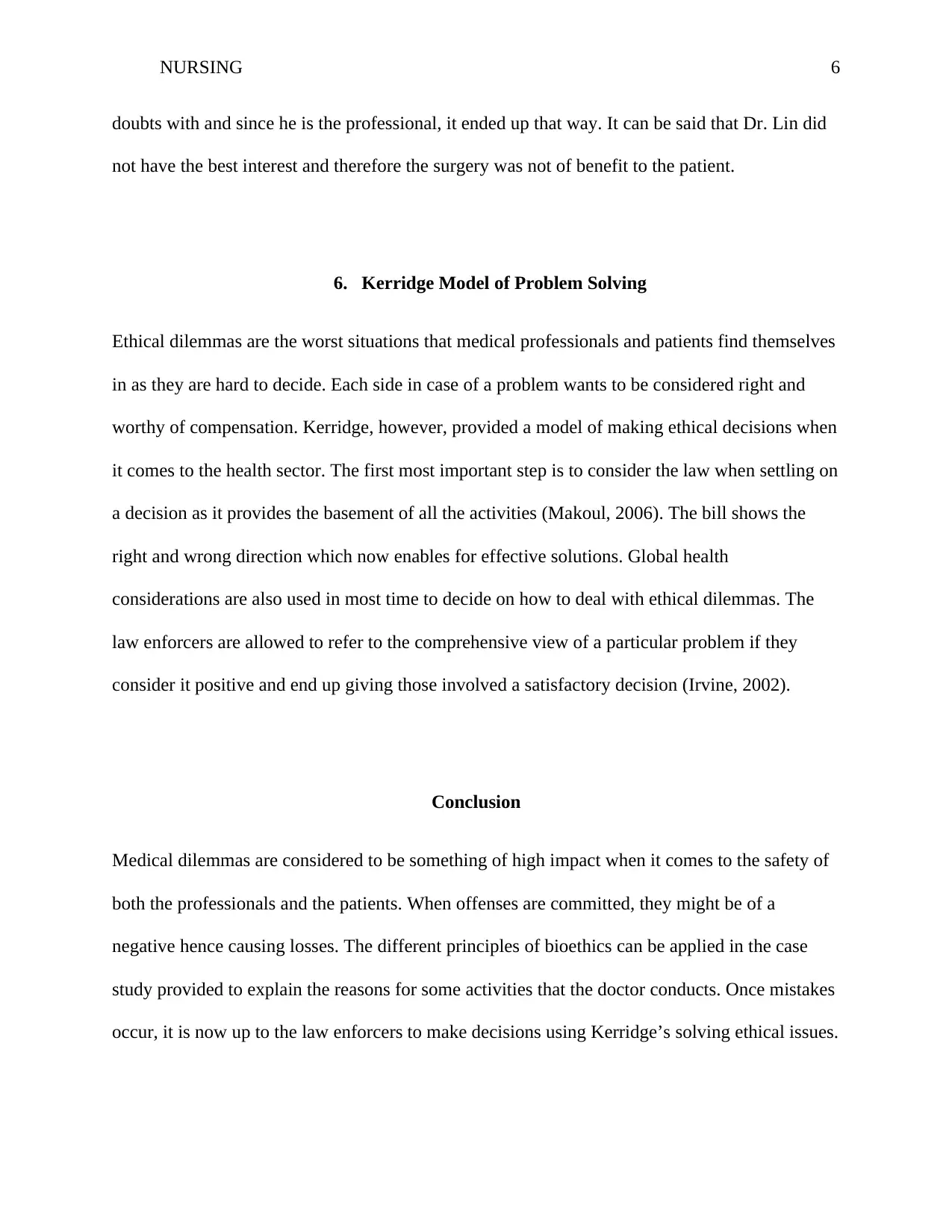
NURSING 6
doubts with and since he is the professional, it ended up that way. It can be said that Dr. Lin did
not have the best interest and therefore the surgery was not of benefit to the patient.
6. Kerridge Model of Problem Solving
Ethical dilemmas are the worst situations that medical professionals and patients find themselves
in as they are hard to decide. Each side in case of a problem wants to be considered right and
worthy of compensation. Kerridge, however, provided a model of making ethical decisions when
it comes to the health sector. The first most important step is to consider the law when settling on
a decision as it provides the basement of all the activities (Makoul, 2006). The bill shows the
right and wrong direction which now enables for effective solutions. Global health
considerations are also used in most time to decide on how to deal with ethical dilemmas. The
law enforcers are allowed to refer to the comprehensive view of a particular problem if they
consider it positive and end up giving those involved a satisfactory decision (Irvine, 2002).
Conclusion
Medical dilemmas are considered to be something of high impact when it comes to the safety of
both the professionals and the patients. When offenses are committed, they might be of a
negative hence causing losses. The different principles of bioethics can be applied in the case
study provided to explain the reasons for some activities that the doctor conducts. Once mistakes
occur, it is now up to the law enforcers to make decisions using Kerridge’s solving ethical issues.
doubts with and since he is the professional, it ended up that way. It can be said that Dr. Lin did
not have the best interest and therefore the surgery was not of benefit to the patient.
6. Kerridge Model of Problem Solving
Ethical dilemmas are the worst situations that medical professionals and patients find themselves
in as they are hard to decide. Each side in case of a problem wants to be considered right and
worthy of compensation. Kerridge, however, provided a model of making ethical decisions when
it comes to the health sector. The first most important step is to consider the law when settling on
a decision as it provides the basement of all the activities (Makoul, 2006). The bill shows the
right and wrong direction which now enables for effective solutions. Global health
considerations are also used in most time to decide on how to deal with ethical dilemmas. The
law enforcers are allowed to refer to the comprehensive view of a particular problem if they
consider it positive and end up giving those involved a satisfactory decision (Irvine, 2002).
Conclusion
Medical dilemmas are considered to be something of high impact when it comes to the safety of
both the professionals and the patients. When offenses are committed, they might be of a
negative hence causing losses. The different principles of bioethics can be applied in the case
study provided to explain the reasons for some activities that the doctor conducts. Once mistakes
occur, it is now up to the law enforcers to make decisions using Kerridge’s solving ethical issues.
⊘ This is a preview!⊘
Do you want full access?
Subscribe today to unlock all pages.

Trusted by 1+ million students worldwide
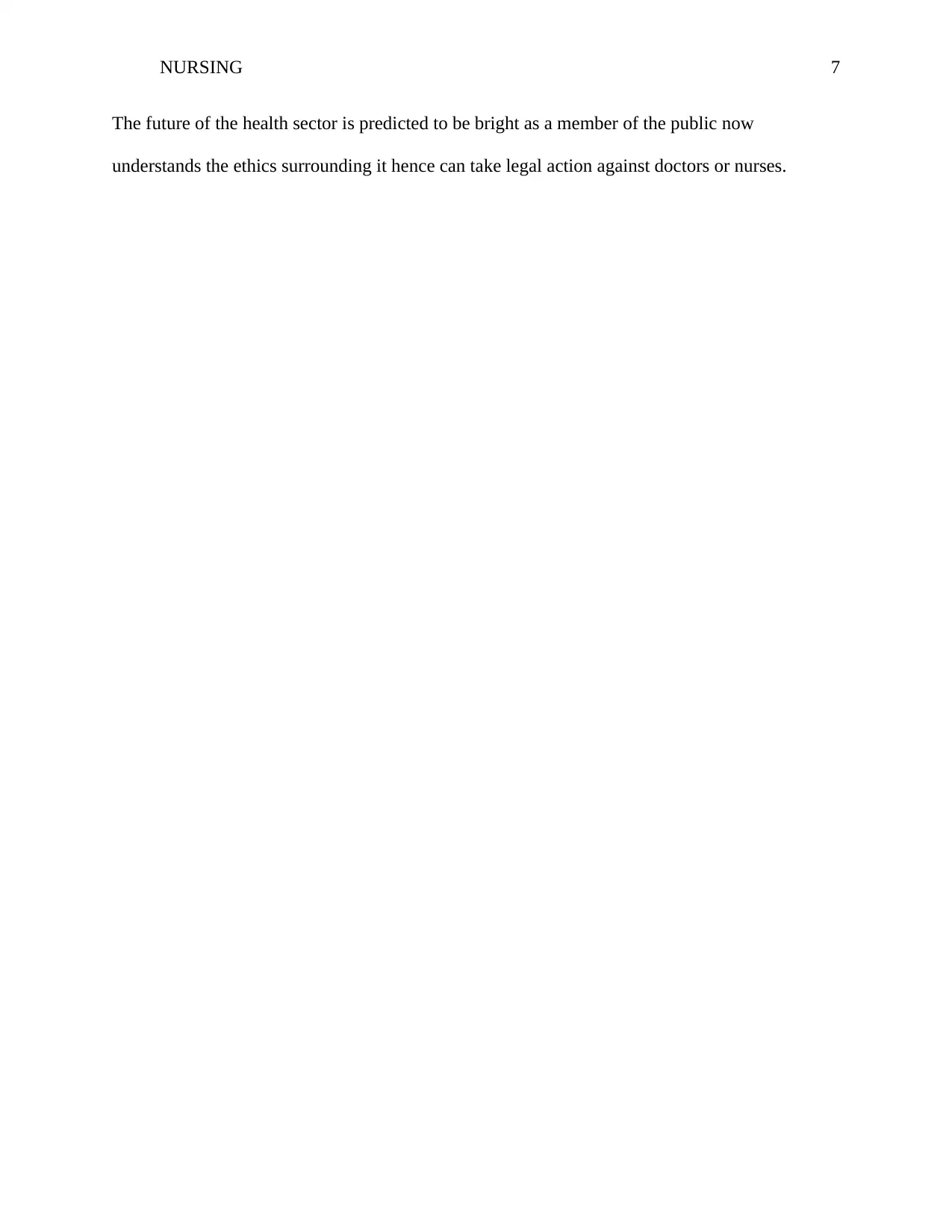
NURSING 7
The future of the health sector is predicted to be bright as a member of the public now
understands the ethics surrounding it hence can take legal action against doctors or nurses.
The future of the health sector is predicted to be bright as a member of the public now
understands the ethics surrounding it hence can take legal action against doctors or nurses.
Paraphrase This Document
Need a fresh take? Get an instant paraphrase of this document with our AI Paraphraser

NURSING 8
References
Appelbaum, P. S. ((2007)). Assessment of patients' competence to consent to treatment. New
England Journal of Medicine, , 357(18), 1834-1840.
Beauchamp. (2001). Principles of biomedical ethics. (Oxford University Press, USA.).
Beauchamp, T. L. (2007). The ‘four principles’ approach to health care ethics. Principles of
health care ethics, 3-10. Lawrence, D. J. (2007). The four principles of biomedical ethics:
a foundation for current bioethical debate. Journal of Chiropracti .
Corrigan, O. (2003). Empty ethics: the problem with informed consent. 25(7), (Sociology of
health & illness), 768-792.
Goldie, J. (2000). Review of ethics curricula in undergraduate medical education. Medical
education. 34(2), 108-119.
Irvine, R. K. (2002). Interprofessionalism and ethics: consensus or clash of cultures?. Journal of
interprofessional care , 16(3), 199-210.
Jordens, C. L. (2005). From advance directives to advance care planning: current legal status,
ethical rationales and a new research agenda. Internal medicine journal , 35(9), 563-566.
Kälvemark, S. H. (2004). Living with conflicts-ethical dilemmas and moral distress in the health
care system. 58(6), (Social science & medicine, ), 1075-1084.
Lo, B. (2012). Resolving ethical dilemmas: a guide for clinicians. . (Lippincott Williams &
Wilkins.).
References
Appelbaum, P. S. ((2007)). Assessment of patients' competence to consent to treatment. New
England Journal of Medicine, , 357(18), 1834-1840.
Beauchamp. (2001). Principles of biomedical ethics. (Oxford University Press, USA.).
Beauchamp, T. L. (2007). The ‘four principles’ approach to health care ethics. Principles of
health care ethics, 3-10. Lawrence, D. J. (2007). The four principles of biomedical ethics:
a foundation for current bioethical debate. Journal of Chiropracti .
Corrigan, O. (2003). Empty ethics: the problem with informed consent. 25(7), (Sociology of
health & illness), 768-792.
Goldie, J. (2000). Review of ethics curricula in undergraduate medical education. Medical
education. 34(2), 108-119.
Irvine, R. K. (2002). Interprofessionalism and ethics: consensus or clash of cultures?. Journal of
interprofessional care , 16(3), 199-210.
Jordens, C. L. (2005). From advance directives to advance care planning: current legal status,
ethical rationales and a new research agenda. Internal medicine journal , 35(9), 563-566.
Kälvemark, S. H. (2004). Living with conflicts-ethical dilemmas and moral distress in the health
care system. 58(6), (Social science & medicine, ), 1075-1084.
Lo, B. (2012). Resolving ethical dilemmas: a guide for clinicians. . (Lippincott Williams &
Wilkins.).
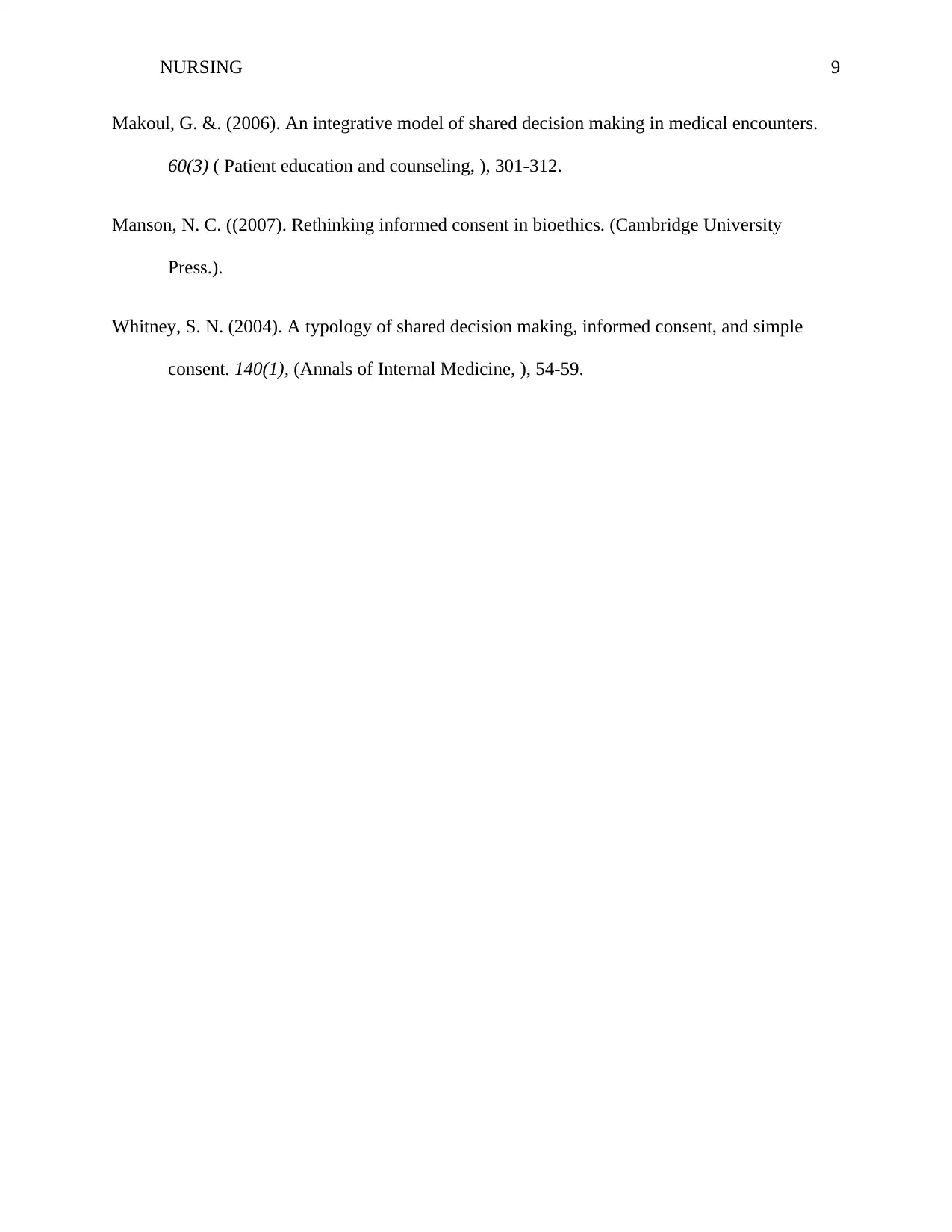
NURSING 9
Makoul, G. &. (2006). An integrative model of shared decision making in medical encounters.
60(3) ( Patient education and counseling, ), 301-312.
Manson, N. C. ((2007). Rethinking informed consent in bioethics. (Cambridge University
Press.).
Whitney, S. N. (2004). A typology of shared decision making, informed consent, and simple
consent. 140(1), (Annals of Internal Medicine, ), 54-59.
Makoul, G. &. (2006). An integrative model of shared decision making in medical encounters.
60(3) ( Patient education and counseling, ), 301-312.
Manson, N. C. ((2007). Rethinking informed consent in bioethics. (Cambridge University
Press.).
Whitney, S. N. (2004). A typology of shared decision making, informed consent, and simple
consent. 140(1), (Annals of Internal Medicine, ), 54-59.
⊘ This is a preview!⊘
Do you want full access?
Subscribe today to unlock all pages.

Trusted by 1+ million students worldwide
1 out of 9
Related Documents
Your All-in-One AI-Powered Toolkit for Academic Success.
+13062052269
info@desklib.com
Available 24*7 on WhatsApp / Email
![[object Object]](/_next/static/media/star-bottom.7253800d.svg)
Unlock your academic potential
Copyright © 2020–2025 A2Z Services. All Rights Reserved. Developed and managed by ZUCOL.





